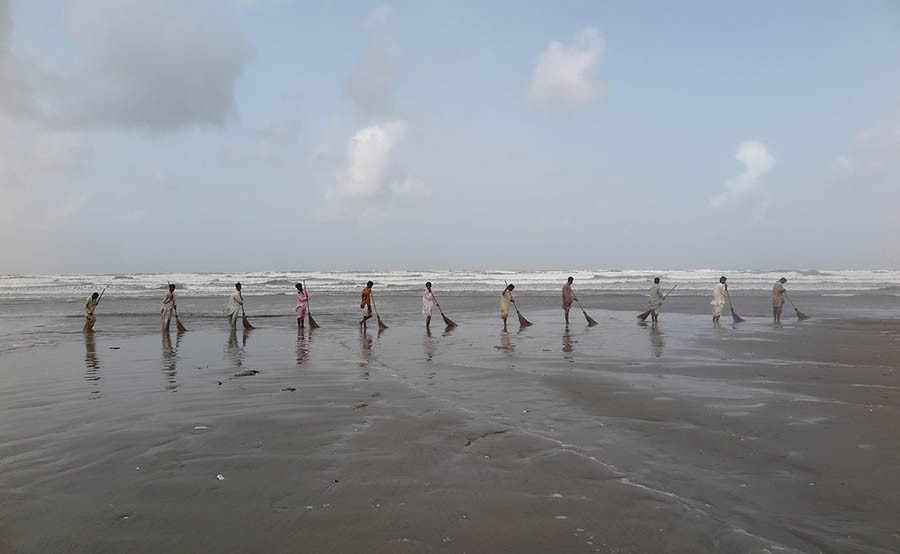
The joint exhibition of Omer Wasim and Saira Sheikh at the Koel Gallery, Karachi captures the ideas of futility and fatality

Not having lived in Karachi, I have no idea how the problem of waste is tackled in the city. But going by recent news and exchanges between politicos, Karachi and kachra make an inseparable pair. A city that is bigger than many countries of Europe population-wise faces the problem of rubbish that accumulates on a daily basis and grows into huge piles that seem unmanageable, to say the least.
Though I do recall a summer when after just an hour’s rain, water accumulated on the main roads of the metropolis, causing huge problem for pedestrians and motorists both. The civic authority deputed a numbers of sanitary workers to evacuate water which they did through their small utensils. This obviously did not help.
The funny and fantastic scene is recalled in Optics of Labour, the joint exhibition of Omer Wasim and Saira Sheikh being held from April 27-May 20, 2017 at the Koel Gallery, Karachi. The duo is not new to the world of Pakistani art. Both already have held a collaborative show at Canvas Gallery Karachi, in which they displayed drawings, photographs, text pieces and objects collected from sites to denote the situation of the city -- through the lives and miseries of its inhabitants; mostly workers doing menial jobs.
In the present exhibition, the two artists have evolved their expression to such a level that one cannot distinguish an individual from his/her partner. More so in the two video installations on two opposite walls of the gallery in which sanitary workers are combing the beach of Karachi. Closer individuals in one and distant figures in the other convey a sense of self-destructive content. Nine men on one side and eleven men in the second projection busy moving their large brooms -- one witnesses a futility of cause and action; it seems a repetitive action, almost on loop.
This subtle link or difference between what you do and what you pretend to produce, so remarkably communicated in that work, alludes to a society that satiates on the state of futility. Looking at the two walls, one realises the minute shift in the movement of these workers who are assigned the herculean task -- of clearing up the vast beach of a city.
In the face of the forceful wind of Karachi, any plan to limit the rubbish to one corner is as stupendous as the desire to contain the art practice of a region in one cultural geography. Like the strong breeze that dispatches particles of dust and debris to unforeseen shores and neighbourhoods, ideas about art cannot be contained within a territorial boundary.
The two video works by Wasim and Sheikh signify an important aspect of our existence: the time we spend in acts which appear sanctimonious but are in essence redundant; the vanity of a human being as individual and part of an organisation. To some extent, the work reminds of fiction of Camus and Kafka in which humans are destined to perform tasks which are assigned to them by nature/invisible body of state.
One can read fatality in the work of Wasim and Sheikh since the idea of cleanliness, in some contexts, verges on ethnic, class and cultural cleansing. In the portrait photographs of eleven sanitary workers, they narrate their personal histories, which denote the structure, system and symptoms of our times. The helplessness of their task and the joy in that uselessness is a mark of our collective pattern because we love to spend time in activities which are trite, trivial and transient.
Wasim and Sheikh capture the essence of that sense of distance and hardness -- much associated with labourers through their portraits and figures. In a set of pictures where each of those nine workers is assigned to clean up (a terrible task in the Indian subcontinent, in the words of V. S. Naipaul, where the mere idea to clean dirt is dirty), the artists capture them in their basic, bare minimal status.
However, the segment that differentiates this group of eleven photographs from any other dossier is the inclusion of a drawer at the base of each frame which once opened starts recounting the life story of that particular person, in his own voice. His narration of his past, present and future offers a scenario in which men are subjugated at various levels. This aspect of turning or treating them purely as working hands becomes more pronounced in a group of another 11 photographs of these very individuals -- but without heads.
The impersonal, almost official, depiction shows how humans are converted into numbers in a state organisation. The fact that their faces were absent but their shadows are collected like a residue of dark ink or water stain under their figures signifies them as segments of machinery which is not a machine either. There is subtlety in choosing men with broom at sand (visually connected to the tiles of Koel Gallery) and precision in portraying figures who have their lives stories that are never heard till you take time and pain to pull out their drawer. Only then you realise that you live in multiple worlds whose every sphere is engaging and enigmatic.
The mere fact that headless figures have flowing kurtas and their shadows are recorded at the base of their feet marks how a person cannot avoid his shadow; that beyond the physical phenomenon of light and shade is his context which the two artists have captured in subtle manner.
Thus the sanitary worker turns into a symbol, a metaphor of his time and place. And not perishes like the dirt and dust of Karachi.